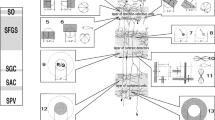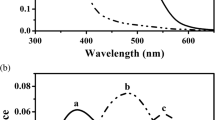Abstract
Integrated spike activity of axons from the optic nerve was measured in an investigation of the e-vector sensitive mechanism underlying the ability of rainbow trout (Oncorhynchus mykiss) for orientation in downwelling, linearly-polarized light. In anaesthetized, immobilized fish, one eye was exposed to incremental light flashes which were superimposed over closely controlled background conditions. Under scotopic and various photopic conditions, intensity/response curves were generated from the on-response of the optic nerve. Relative sensitivity curves were then obtained as a function of e-vector direction for the 5 kinds of receptor cells in this trout's retina: rods, ultraviolet cones (UV), short wavelength cones (S), medium wavelength cones (M), and long wavelength cones (L).
Under scotopic conditions, no sensitivity to e-vector was apparent: thus, rods do not mediate polarization sensitivity. Under photopic conditions, parr weighing 8–10 g exhibited e-vector sensitivity in two orthogonal channels. A UV stimulus (380 nm) on a white background evoked a three-peaked response (0°, 90°, and 180°) to the e-vector orientations presented in 30° increments between 0° and 180°. In contrast, when the background was illuminated with appropriate short and long wavelength cut-off filters, M-and L-cones showed maximum responses only to the horizontal (90°) plane whether they were stimulated at their α-absorption band or their β-absorption band in the near UV. Isolated UV-cones gave maximum responses to the vertical (0° and 180°) e-vector, thus corresponding to a second channel. The blue sensitive, S-cones, did not show evidence of polarization sensitivity. As well, no evidence of the polarization sensitivity was observed under UV isolating background conditions in larger individuals, 50–78 g smolts, although the other cone mechanisms responded as in smaller individuals.
Similar content being viewed by others
References
Ali MA (1975) Retinomotor responses. In: Ali MA (ed) Vision in fishes. Plenum Press, New York, pp 313–355
Bernard GD, Wehner R (1977) Functional similarities between polarization vision and color vision. Vision Res 17:1019–1028
Bowmaker JK, Kunz YW (1987) Ultraviolet receptors, tetrachromatic colour vision and retinal mosaics in brown trout (Salmo trutta): Age dependent changes. Vision Res 27:2101–2108
Cameron NE (1982) The photopic spectral sensitivity of a dichromatic teleost fish (Perca fluviatilis). Vision Res 22:1341–1348
Cameron DA, Pugh EN (1991) Double cones as a basis for a new type of polarization vision in vertebrates. Nature 353:161–164
Coemans M, Vos J, Nuboer J (1990) No evidence for polarization sensitivity in the pigeon. Naturwissenschaften 77:138–142
Coughlin DJ, Hawryshyn CW (1993) The contribution of ultraviolet and short-wavelength sensitive cone mechanisms to color vision in rainbow trout. Brain Behav Evol (in press)
Davitz MA, MacKaye KR (1978) Discrimination between horizontally and vertically polarized light by the cichlid fish Pseudotropheus macrophthalmus. Copeia 2:333–334
DeMarco PJ Jr, Powers MK (1991) Spectral sensitivity of On and Off responses from the optic nerve of goldfish. Visual Neurosci 6:207–217
Dill PA (1971) Perception of polarized light by yearling sockeye salmon. J Fish Res Board Canada 28:1319–1322
Douglas RH, Wagner HJ (1982) Endogenous patterns of photomechanical movements and their relationship to activity rhythms in teleosts. Cell Tissue Res 226:133–144
Eakin (1968) Evolution of photoreceptors. Am Sci 2:194–242
Fein A, Szuts EZ (1982) Photoreceptors and their role in vision. IUPAB Biophysics Series. Cambridge Univ Press, Cambridge, 212 pp
Forward RB Jr, Waterman TH (1972) Evidence for e-vector and light intensity pattern discrimination by the teleost Dermogenys sp. J Comp Physiol 87:189–202
Forward RB Jr, Horch KW, Waterman TH (1972) Visual orientation at the water surface by the teleost Zenarchopterus. Biol Bull 143:112–126
Foster DH, Ward PA (1991) Asymmetries in oriented-line detection indicate two orthogonal filters in early vision. Proc R Soc Lond B 243:75–81
Groot C (1965) On the orientation of young sockeye salmon (Oncorhyncus nerka) during their seaward migration out of lakes. Behaviour [Suppl.] 14:198 pp
Hawryshyn CW (1991a) Light-adaptation properties of the ultraviolet-sensitive cone mechanism in comparison to the receptor mechanisms in goldfish. Visual Neurosci 6:293–301
Hawryshyn CW (1991b) Spatial summation of cone mechanisms in goldfish. Vision Res 31:563–566
Hawryshyn CW (1992) Polarization vision in fishes. Am Sci 80:164–175
Hawryshyn CW, Beauchamp RD (1985) Ultraviolet photosensitivity in goldfish: an independent UV mechanism. Vision Res 25:11–20
Hawryshyn CW, Bolger AE (1990) Spatial orientation of trout to partially polarized light. J Comp Physiol A 167:691–697
Hawryshyn CW, McFarland WN (1987) Cone photoreceptor mechanisms and the detection of polarized light in fish. J Comp Physiol A 160:459–465
Hawryshyn CW, Arnold MG, Chaisson DJ, Martin PC (1989) The ontogeny of ultraviolet photosensitivity in rainbow trout. Vis Neurosci 2:247–254
Hawryshyn CW, Arnold MG, Bowering E, Cole RL (1990) Spatial orientation of rainbow trout to plane-polarized light: the ontogeny of E-vector discrimination and spectral sensitivity characteristics. J Comp Physiol A 166:565–574
Jagger WS (1992) The optics of the spherical fish lens. Vision Res 32:1271–1284
Jerlov NG (1976) Marine optics. Elsevier, Amsterdam
Jolly DW, Mawdesley-Thomas LE, Bucke D (1972) Anaesthesia of fish. Veterinary Record 91:424–426
Kawamura G, Shibita A, Yonimori T (1981) Response of teleosts to the plane of polarized light as determined by heart rate. Bull Jpn Soc Sci Fish 47:727–729
Kleerekoper H, Matis JH, Timms AM, Gesler P (1973) Locomotor response of the goldfish to polarized light and its e-vector. J Comp Physiol 86:27–36
La Vail MM (1976) Rod outer segment disc shedding in relation to cyclic lighting. Exp Eye Res 23:277–280
Loew ER, McFarland WN (1990) The visual environment. In: Douglas RH, Djamgoz MBA (eds) The visual system of fish. Chapman and Hall, London, pp 1–43
Lythgoe J (1979) Ecology of vision. Oxford Univ Press, Oxford
Martin GR (1991) The question of polarization. Nature 350:194
Sivak JG, Mandelman T (1982) Chromatic dispersion of the ocular media. Vision Res 22:997–1003
Stys PK, Ransom BR, Waxman SG (1991) Compound action potential of nerve recorded by suction electrode: a theoretical and experimental analysis. Brain Res 546:18–32
Waterman TH (1966) Mechanisms of polarized light perception. Science 154:467–475
Waterman TH, Aoki K (1974) E-vector sensitivity patterns in the goldfish optic tectum. J Comp Physiol 95:13–45
Waterman TH, Hashimoto H (1974) E-vector discrimination by goldfish optic tectum. J Comp Physiol 95:1–12
Wehner R (1983) The perception of polarized light. In: Cosens DJ, Vince-Price D (eds) The biology of photoreception. Soc Exp Biol, pp 331–369
Wheeler TG (1979a) Retinal on and off responses convey different chromatic information to the CNS. Brain Res 160:145–149
Wheeler TG (1979b) Retinal red sensitivity under dark-adapted conditions. Brain Res 175:140–145
Author information
Authors and Affiliations
Rights and permissions
About this article
Cite this article
Parkyn, D.C., Hawryshyn, C.W. Polarized-light sensitivity in rainbow trout (Oncorhynchus mykiss): characterization from multi-unit responses in the optic nerve. J Comp Physiol A 172, 493–500 (1993). https://doi.org/10.1007/BF00213531
Accepted:
Issue Date:
DOI: https://doi.org/10.1007/BF00213531




